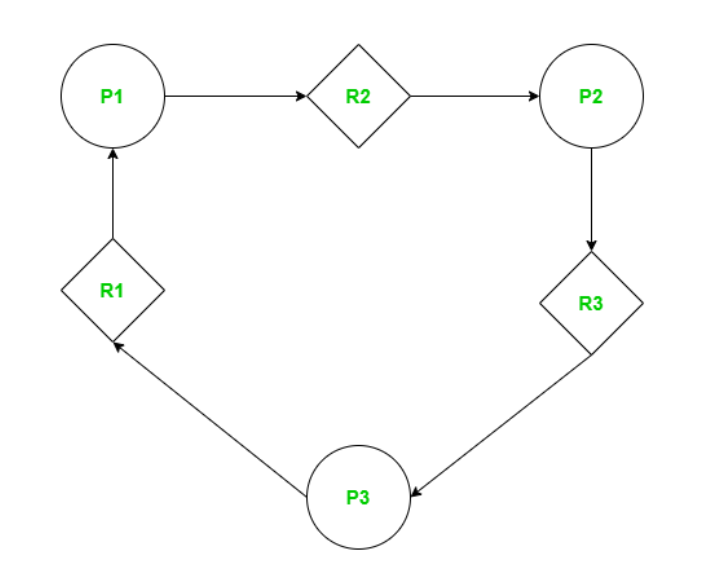Phantom Deadlock in Distributed System
Last Updated :
11 Sep, 2023
Phantom deadlocks, in distributed systems, refer to situations where multiple processes or threads get stuck and can’t move forward because of conflicts in synchronization and resource allocation. This happens when different tasks are being executed at the time causing each process to wait for a resource that is held by another process. This creates a dependency that brings the system to a halt.
The Mechanism Behind Phantom Deadlocks
Phantom deadlocks usually happen because of a combination of factors like synchronization mechanisms, strategies for allocating resources, and the inherent complexities of distributed systems. Unlike deadlocks, where resources are explicitly locked and blocked phantom deadlocks often occur due, to dependencies that are not immediately obvious.
Why Do Phantom Deadlocks Occur?
There are several reasons for deadlock to occur few of which are mentioned below
- In distributed systems, multiple nodes may request resources from each other such as files, locks, or data to carry out tasks.
- Due to network delays and the asynchronous nature of communication nodes might not receive responses to their resource requests. This can lead to communication delays.
- Sometime nodes may lack time and comprehensive information about the systems resource allocation and utilization. As a result they might misinterpret the information due to knowledge.
Example:
Let’s understand it better with the help of an example:

Phantom Deadlock
In this diagram,
- The arrows show the relationships of waiting.
- For instance P1 is waiting for R2. P2 is waiting for R3.
- There seems to be a pattern of waiting; P1 is waiting for R2 P2 is waiting for R3 and P3 is waiting for R1.
- This circular pattern suggests a deadlock.
In this WFG representation of the workflow we have three processes (P1, P2, P3) and three resources (R1, R2, R3). The arrows indicate the relationships where processes are waiting for resources or holding them.
- Process P1 and Resource R2: Process P1 is currently waiting for Resource R2. This implies that P1 has made a request, for R2 and cannot proceed until it obtains it. The reason behind this waiting situation could be resource unavailability or the need for synchronization.
- Resource R2 and Process P2: Process P2 is currently holding Resource R2. This indicates that P2 has acquired control over R2 causing other processes like P1 to wait until it is released.
- Resource R2 and Resource R3:There is also a waiting relationship between Resource R2 and Resource R3. This suggests that having access to R2 is a prerequisite, for utilizing or depending on R3 creating a chain dependency.
- Resource R3 and Process P2:Process P2 is currently waiting for Resource R3. This implies that PProcess P2 is currently, in a state of pause as it awaits the availability of Resource R1. Similar to instances where processes are waiting P2s advancement is put on hold until it successfully obtains access to R1.
- Resource R1 and Process P3: At present Process P3 is also in a state of waiting as it awaits the availability of Resource R1. This forms a cycle, where P3s wait for R1 connects back, to P1s wait for R2 resulting in a pattern of dependencies.
The circular arrangement of waiting relationships, among processes and resources is an indication that a potential phantom deadlock may occur. Phantom deadlocks arise when these logical dependencies cause processes to wait indefinitely even if there is no blocking of resources as seen in deadlocks. It is crucial to identify these patterns using techniques such as the WFG (Wait for Graph) to understand and address deadlocks effectively in distributed systems.
FAQs on Phantom Deadlock in Distributed System
1. What exactly is a phantom deadlock?
Unlike deadlocks caused by resource conflicts a phantom deadlock occurs in distributed systems due to inconsistencies in data.
2. How do synchronized timestamps help prevent phantom deadlocks?
By ensuring that data remains consistent across nodes through synchronized timestamps we can reduce the chances of conflicting updates and situations that lead to deadlocks.
3. What are dynamic locking mechanisms?
Dynamic lock mechanisms enable locks to be acquired and released according to evolving data, which decreases the chances of conflicting access and potential phantom deadlocks.
4. Is it possible for data corruption to occur due, to deadlocks?
Absolutely. Phantom deadlocks have the potential to cause data corruption, incomplete transactions and system slowdowns. These issues can significantly impact the performance of distributed systems.
Share your thoughts in the comments
Please Login to comment...